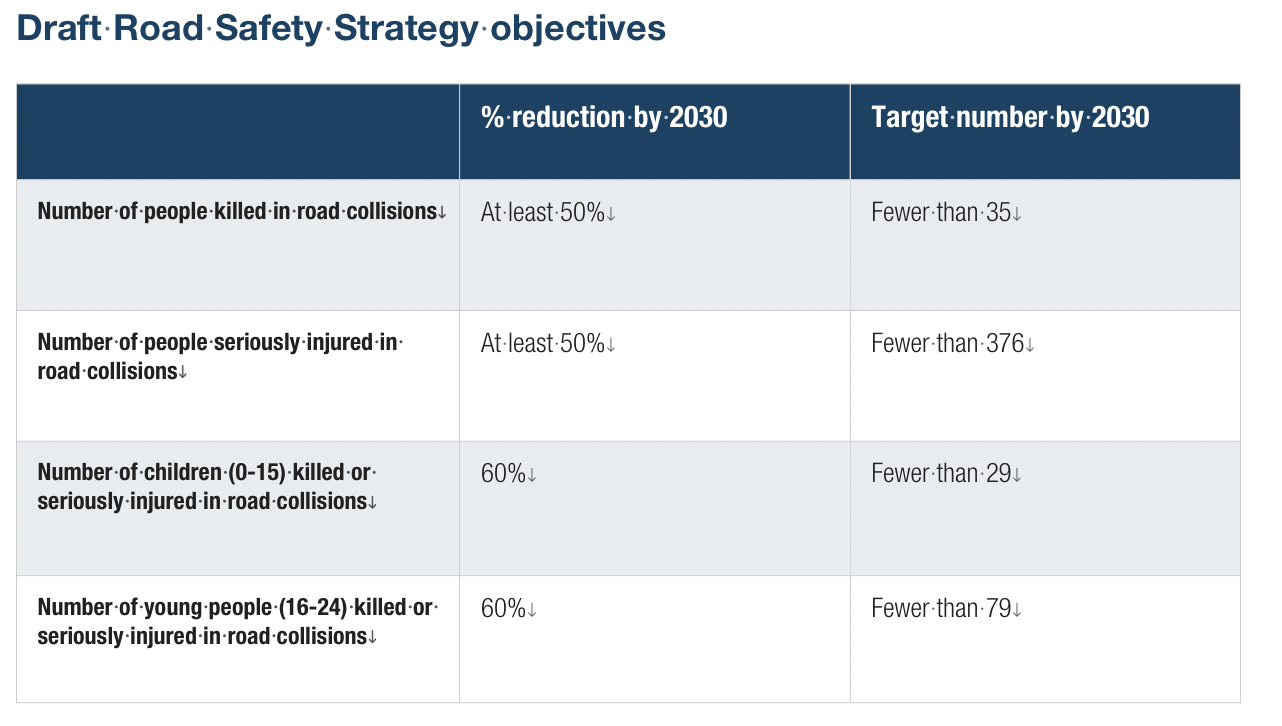Ambitious targets for road death reduction

A draft Road Safety Strategy outlines ambitious targets of halving the numbers of deaths and injuries on Northern Ireland’s roads by 2030.
The draft strategy outlines a target of 35 or less deaths by road accidents by 2030, with a target of 376 or less injuries on Northern Ireland’s roads by 2030.
Statistics from the Department for Infrastructure show a consistent decline in deaths from road traffic collisions throughout the 2010s, with the figure having reduced from an average of 126 between 2004 and 2008 to a figure of 50 by 2021.
The strategy sets an ambition of a 60 per cent reduction in young people suffering road deaths or serious injury by 2030.
In the long term, the strategy outlines an ambition for zero road deaths or serious injuries in Northern Ireland by 2050.
To achieve this, the draft document states that the Department for Infrastructure will expand the use of initiatives such as 20 miles per hour (mph) limits outside schools and the use of speed indicator devices.
The Police Service of Northern Ireland (PSNI) data continues to show that approximately 95 per cent of road casualties are due to a number of dangerous road user behaviours with the majority of collisions being caused by carelessness/inattention, driving at excessive speed, or through alcohol/drugs despite interventions to date. Additionally, uncertainties remain as to the lasting impacts of the Covid-19 pandemic on travel choices and behaviours.
Progress made against previous strategy
The new strategy, if implemented, will act as a successor to the Northern Ireland Road Safety Strategy to 2020. The main strands of the previous strategy included the introduction of 20mph zones around vulnerable trafficking zones such as around schools, as well as a maintenance of focus on well-established marketing campaigns.
The draft document outlines the progress made against the previous road safety strategy through the 2010s until 2020. Launched under former Environment Minister Edwin Poots MLA, the targets outlined were measured against base numbers established in the period between 2004 and 2008.
The previous strategy targeted a reduction in deaths from road traffic collisions of 60 per cent by 2020, a target which was not met by 2020, although it was in 2021, a year behind schedule, (there is the added caveat of the reduced amount of road usership emanating from the Covid-19 pandemic).
Northern Ireland, Britain, and the Republic of Ireland have among the best relative records on road safety in the European continent, with all three states having a road death rate below 30 per one million people. For context, France and the Netherlands both have death rates of between 31 and 40 per one million.
Changing attitudes
The Department for Infrastructure, in January 2023, released statistics which outline the scale of the challenge of halving the numbers of road deaths and injuries roads by 2030.
58 per cent of road users who took part in the survey admitted to using their mobile phones whilst driving.
Despite this high level of mobile phone usage whilst driving, users are acutely aware of the risk associated with such actions. 94 per cent of road users stated that they believed that using a mobile phone whilst driving increased their likelihood of being involved in an accident.
The survey further states that 90 per cent of road users correctly assume that the presence of street lights translates into a 30mph limit. A point for concern is that a small number of respondents found it acceptable to drive at 70mph in an area with street lights, pointing to the potential danger posed by a minority of road users.
Challenges for implementation
Having been announced in draft format, implementation of the strategy requires sign-off from the Northern Ireland Executive, which remains absent as the DUP boycotts the institutions in an attempt to leverage influence over the UK Government to change the Northern Ireland Protocol.
Announcing the draft strategy in October 2022, then-Minister for Infrastructure John O’Dowd MLA stated: “Unfortunately, due to the ongoing absence of an Executive, it has not been possible for me to deliver a final strategy at this time. I have however sought support from ministerial colleagues to allow my officials to continue to develop preparatory work, and to co-ordinate with other Departments, on the final form of this Strategy in anticipation of the return of a functioning Executive.”






